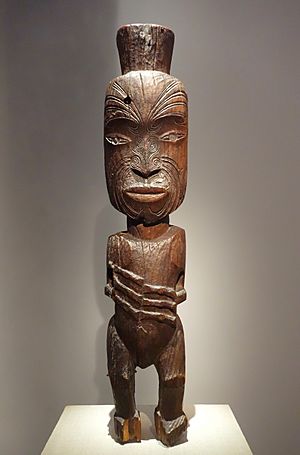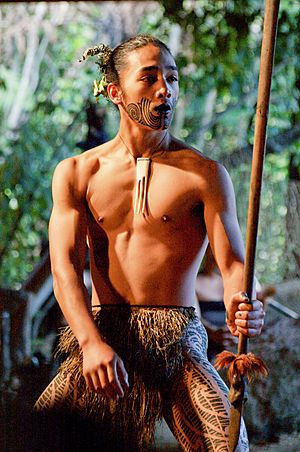Culture of New Zealand facts for kids
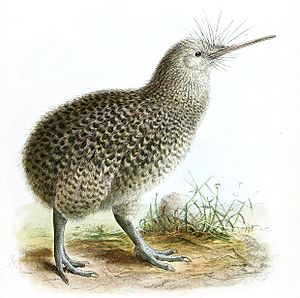
The culture of New Zealand is a mix of Western ideas and the special ways of life of the Māori, who are the first people of the islands. New Zealand's unique environment and its distance from other countries have also shaped its culture. Over time, many different groups of people have moved to New Zealand, adding to its rich cultural mix.
Polynesian explorers first arrived in New Zealand between 1250 and 1300 CE. Over hundreds of years, Māori culture grew from these Polynesian beginnings. Māori people formed different tribes, built strong villages called Pā, and became skilled at hunting, fishing, farming, and trading. They also created beautiful art, weapons, and kept detailed oral histories.
Europeans started regular contact around 1800, and many British people began moving to New Zealand, especially after 1855. These new settlers brought Christianity, new technology, the English language, and new ways of learning to read and count. In 1840, Māori chiefs signed the Treaty of Waitangi, hoping to live peacefully with the settlers. However, conflicts known as the New Zealand wars broke out from 1845. Māori lost much of their land, partly through fighting and partly through land sales. Even so, Māori kept their identity, often living separately and continuing to speak te reo Māori.
European New Zealanders (also called Pākehā) kept strong ties to Britain at first. But as the British Empire changed, Pākehā started to create their own identity. This new identity was shaped by their pioneering history, a rural lifestyle, and New Zealand's unique environment. Later, efforts were made to include Māori culture and the Treaty of Waitangi in schools, helping Māori and Pākehā understand each other better.
More recently, New Zealand's culture has become even wider due to people moving from the Pacific Islands, East Asia, and South Asia. You can see other Polynesian cultures, for example, at Pasifika, the world's largest Polynesian festival, which happens every year in Auckland.
New Zealand has two national days to remember important events: Waitangi Day and ANZAC Day. They also celebrate holidays linked to the founding dates of each region. New Zealand has two national anthems: "God Save the King" and "God Defend New Zealand". The second one is often sung with verses in both Māori and English. Many people in New Zealand like to think of themselves simply as New Zealanders or Kiwis.
Contents
Māori culture
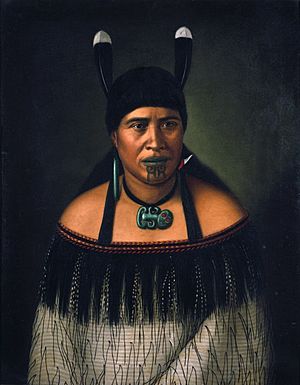
The Māori are the native Polynesian people of New Zealand, also known as Aotearoa. They first arrived around 1280 CE from Eastern Polynesia, likely the Society Islands. About 100-200 Polynesian migrants arrived at that time. Māori settled the islands and created their own special culture over several hundred years.
Their oral history tells of a long journey from Hawaiki (a mythical homeland) in large ocean-going canoes called waka. Māori mythology has its own unique gods and heroes, like Rangi and Papa, Māui, and Kupe.
A very important place for Māori cultural events is the marae. This is where families and tribes gather for special occasions, such as welcoming ceremonies (pōwhiri) or funerals (tangi). Māori often call themselves "tāngata whenua" (people of the land). This shows how important it is to them to live connected to the land and sea. Sharing and living off the land are strong traditional values.
The unique values, history, and way of seeing the world for Māori are shown through their traditional arts and skills. These include the haka (a powerful dance), tā moko (traditional tattooing), waiata (songs), carving, weaving, and poi (a performance art with balls on cords). The idea of tapu (meaning sacred or forbidden) is also very important in Māori culture. It applies to objects, people, or even mountains.
As more Europeans arrived from 1855, Māori society changed. The Treaty of Waitangi in 1840 set up British rule in New Zealand. There were serious conflicts between Māori and European settlers, especially between 1863 and 1864. This led to land being taken from some defeated tribes. However, Māori also sold much of their land after 1870. From the 1820s, the Māori population and culture faced a long period of decline. But their numbers began to grow again in the late 1800s. A cultural revival, sometimes called the Māori Renaissance, started in the 1960s.
Pākehā culture
Pākehā culture mostly comes from the British, especially English settlers who moved to New Zealand in the 1800s. Even though it's similar to British culture, it has always had its own differences, which have grown over time. For example, Pākehā culture often shows more egalitarianism, meaning people believe everyone is equal. There's also a strong idea that most people can achieve things if they try hard. Within Pākehā culture, there are also smaller groups from Irish, Italian, and other European backgrounds.
Some people used to say that Pākehā didn't really have their own culture. This was partly because "high culture" (like classical art or music) was often confused with culture in general. Also, New Zealand artists, writers, and composers didn't always get much recognition in the past. However, Pākehā pop culture is usually very visible and valued.
Another idea is that Pākehā culture was seen as "normal" or "default," while other cultures were seen as "ethnic" or different. Groups working against racism in the 1980s helped Pākehā see their own culture as unique, rather than just the standard.
A common saying about Kiwi culture is that it's based on "rugby, racing, and beer." Many New Zealanders play or support their local rugby team. The All Blacks are national heroes. Some even say that rugby is like a national religion in New Zealand.
Cultural borrowing and adaptation
Māori borrowing from Pākehā culture
Since Europeans arrived, Māori have adopted many parts of Pākehā culture. From the 1830s, many Māori became Christian and learned to read and write. By the late 1800s, Māori were just as likely to be able to read and write as Pākehā. Some new religions, like Pai Marire and Ringatu, appeared in the 1800s. These religions mixed Māori traditions with Christianity.
Māori also put their traditional chants to European music or wrote them to European tunes. Carvers started using European designs and metal tools, which changed their style. British fabrics and cloth were used to make new types of clothing. Horses became popular, especially on the East Coast. European tools and weapons were often decorated with traditional Māori carvings. From the 1820s, Māori also began building boats using European methods. Many of these activities were done with Pākehā traders and settlers.
After some conflicts, Pākehā numbers grew larger than Māori numbers. This meant Māori had less choice about adopting Pākehā culture. The government passed laws affecting Māori, like the Native Schools Act (1867), which said English should be the main language taught to Māori children. Māori generally supported this idea. Most Māori encouraged their children to learn English and Pākehā ways of life to succeed in the economy and society. From the 1880s, a few Māori graduates from colleges like Te Aute emerged. Men like Pomare, Ngata, and Buck believed that adopting more Pākehā culture would help Māori in New Zealand. They formed the Young Māori Party, which greatly helped improve health and education for Māori. They also wanted to bring back interest in Māori arts and crafts. Ngata became a leading New Zealand politician.
As Western technology like electricity, roads, and radio became common, many parts of traditional Māori culture became less important in daily life. However, they were still practiced at special events like funerals (tangi). From the early 1900s, and especially from the 1970s, Māori activists began to protest against too much focus on European culture. They demanded equal recognition for their own culture.
Many Māori have become very successful in European art forms. Some of New Zealand's biggest art stars are Māori or part Māori. These include opera singers Inia Te Wiata and Kiri Te Kanawa, novelists Keri Hulme (who won the Booker Prize) and Alan Duff, poet Hone Tuwhare, and painter Ralph Hotere. Actors like Temuera Morrison and Cliff Curtis, and director Lee Tamahori are also well-known. Māori culture has also inspired Pākehā artists.
Pākehā borrowing from Māori culture
Since the late 1800s, Pākehā have used Māori cultural practices when they wanted something unique. The most famous example is the haka of the All Blacks, the national rugby team. They perform this Māori posture dance before international rugby matches. Many Pākehā artists, like Colin McCahon and Gordon Walters, have also used Māori designs in their art. Early Pākehā writers used Māori themes to create a truly New Zealand literature. The tourism industry also uses Māori culture a lot to offer visitors unique New Zealand experiences. Many New Zealanders living overseas use Māori culture to show they are from New Zealand. An example is the large haka performed in Parliament Square in London every Waitangi Day.
For many years, Pākehā did not always ask Māori before using their culture. Māori usually didn't protest much unless a symbol was used in a very disrespectful way. From the 1970s, Māori began to object more to Pākehā using their culture, especially when it was disrespectful. For example, in 1979, some university students had a tradition of performing a fake haka at graduation. After Māori students asked them to stop, a group protested. This event led to more discussions about respecting Māori culture. Now, most Pākehā are more respectful and often ask Māori before using Māori cultural forms. However, sometimes forms are still used in ways that are not appropriate.
Some Pākehā have helped bring back Māori arts that were almost lost. Richard Nunns is highly respected for his work with traditional Māori musical instruments. Many academics, like Dame Anne Salmond and Mervyn McLean, have also contributed greatly to understanding Māori rituals and songs. Māori history has mostly been written by Pākehā authors like Michael King and James Belich. Traditionally, Māori were careful about sharing their tribal knowledge with Europeans, fearing it might be mocked or misunderstood.
Borrowing from overseas
Both Māori and Pākehā have adopted cultural forms and styles from other countries, especially Britain and the United States. Most popular New Zealand music comes from Anglo-American styles, like rock music, hip-hop, and electronic dance music. While there's a "New Zealand style," many groups add New Zealand themes to their work. More recently, from the early 2000s, styles like Dub-step and Drum and Bass from England have been developed into a unique New Zealand sound by bands like Salmonella Dub and Shapeshifter.
Visual arts have also been influenced by international movements, such as cubism in the early work of Colin McCahon. Generally, the growth of international mass media means New Zealanders have always known about new developments in other countries. This makes it easy to adopt new forms and styles from overseas.
Languages
New Zealand has three official languages: New Zealand English, Te Reo Māori (the Māori language), and New Zealand Sign Language. In everyday life, English is the most widely used, but big efforts have been made recently to help Te Reo Māori grow. Many other languages are spoken in New Zealand because of its diverse population.
New Zealand English
New Zealand English sounds very similar to Australian English, but there are some differences. The main differences are in how certain short vowel sounds are pronounced. For example, the "i" in "kit" sounds a bit like the "a" in "about." Some of these differences show that New Zealand English is more like the English spoken in southern England than Australian English is. Some differences also show the influence of Māori speech. The New Zealand accent also has some Scottish and Irish influences because many settlers from those places came in the 1800s. In 2013, 93% of the population spoke English.
Te Reo Māori
Te Reo Māori is an Eastern Polynesian language. It is closely related to Tahitian and Cook Islands Māori, and a bit less to Hawaiian. The language was used less after European settlement. However, since the 1970s, efforts have been made to bring it back. These efforts include making it an official language with the Māori Language Act 1987, having a Māori language week, and a Māori Television channel. In 2013, 3.7% of the population spoke Māori.
New Zealand Sign Language
New Zealand Sign Language (NZSL) comes from British Sign Language (BSL). About 62.5% of NZSL signs are similar to BSL, compared to only 33% with American Sign Language. Like other natural sign languages, it was created by and for Deaf people. It has no connection to spoken or written language and can express anything a fluent signer wants to say. NZSL uses more lip-patterns along with hand and face movements than BSL. Its vocabulary includes Māori ideas like marae and tangi, and signs for New Zealand place names. New Zealand Sign Language became an official language in April 2006. About 20,000 people use NZSL.
Other languages
According to the 2013 census, 174 languages are used in New Zealand, including sign languages. Samoan is the most spoken non-official language (2.2%), followed by Hindi (1.7%), "Northern Chinese" (including Mandarin, 1.3%), and French (1.2%).
Arts
New Zealand has two main "high cultural" traditions: Māori and Western. However, most cultural things people enjoy in New Zealand come from overseas, especially from Britain and the United States. Because of this and New Zealand's small population, many New Zealand artists, performers, and writers find it hard to make a living from their art. Some money for the arts comes from a government department called Creative New Zealand. Heritage New Zealand and the Ministry for Culture and Heritage help protect national heritage. Most towns and cities have museums and art galleries. The national museum and art gallery is Te Papa ('Our Place'), located in Wellington.
Visual arts
Before Europeans arrived, Māori visual art had two main forms: carving and weaving. Both were used to record stories and legends, and also had religious meanings.
When settlers arrived, they brought Western art traditions. Early Pākehā art often focused on painting landscapes. Some well-known Pākehā artists of the 1800s, like Charles Goldie and Gottfried Lindauer, specialized in painting Māori portraits. Some Māori adopted Western styles. From the early 1900s, Āpirana Ngata and others started a program to bring back traditional Māori arts. Many new meeting houses were built with traditional carvings and woven wall panels called tukutuku. Pākehā artists have long tried to create a unique New Zealand artistic style. Rita Angus used the landscape to do this, while painters like Gordon Walters used Māori designs. Some Māori artists, including Paratene Matchitt and Shane Cotton, have mixed Western modern art with traditional Māori art.
Performing arts
Kapa haka
Kapa haka is the 'cultural dance' part of traditional Māori Performing Arts. "Kapa" means 'rank' or 'row', and "haka" refers to a Māori dance. Kapa haka is a way for Māori people to show their heritage and cultural identity through song and dance. It has become very popular again, with national competitions held yearly. Kapa haka is also used at many official state events. The haka (often thought of as only a war dance) has become part of wider New Zealand culture. The All Blacks perform it before international games. New Zealanders of all backgrounds living overseas also perform it to show their connection to New Zealand.
Drama
New Zealand drama, both on stage and screen, has faced challenges like high costs and a lack of public interest in New Zealand stories. Despite this, Roger Hall and, more recently, Jacob Rajan are two playwrights who have become very popular. In recent decades, New Zealand film has grown a lot. Films like Once Were Warriors, The Piano, and Heavenly Creatures did well both in New Zealand and around the world. Director Peter Jackson, known for The Lord of the Rings trilogy, has become one of the most successful film directors. New Zealand's most popular comedian was the late Billy T. James.
Music
New Zealand music has been influenced by blues, jazz, country, rock and roll, and hip hop. Many of these styles have been given a unique New Zealand twist. Hip-hop is popular, and there are small but lively live music, dance party, and indie music scenes. Reggae is also popular in some communities, with bands like The Herbs, Katchafire, and 1814 showing their roots and cultural pride through their music.
Many popular artists have become internationally successful, including Lorde, Split Enz, Crowded House, OMC, Bic Runga, Kimbra, Ladyhawke, Fat Freddy's Drop, Savage, Flight of the Conchords, and Brooke Fraser.
New Zealand has a national orchestra and many regional orchestras. Several New Zealand composers have gained international fame. The most well-known include Douglas Lilburn, John Psathas, and Gillian Whitehead.
Comedy
In recent decades, New Zealand comedians have become more popular and recognized. In the 1970s and 1980s, Billy T James made jokes about race relations. McPhail and Gadsby made fun of political figures. John Clarke, also known as Fred Dagg, joked about rural life. Raybon Kan is a well-known Asian comedian. The Topp Twins are a unique comedy and country music duo. Flight of the Conchords have become famous worldwide for their humble and funny show.
Literature
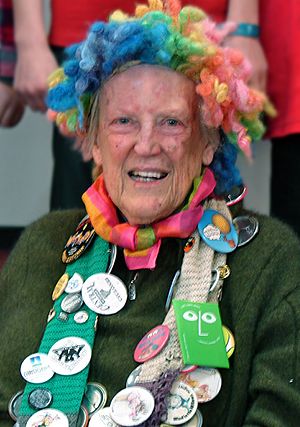
New Zealand's most successful early writers were people who lived overseas, like Katherine Mansfield. From the 1950s, writers like Frank Sargeson and Janet Frame had writing careers while living in New Zealand. Until about the 1980s, the main New Zealand writing style was the short story. But in recent decades, novels like Alan Duff's Once Were Warriors and Elizabeth Knox's The Vintner's Luck have become popular and praised by critics. Māori culture is traditionally oral, meaning stories are spoken rather than written. However, in recent years, Māori novelists like Duff, Witi Ihimaera, and Keri Hulme, and poets like Hone Tuwhare, have shown their skill in European writing styles. Austin Mitchell wrote two "Pavlova Paradise" books about New Zealand life. Barry Crump was a popular author who wrote about the idea of the "Kiwi larrikin" – a fun-loving, multi-skilled worker. Sam Hunt and Gary McCormick are well-known poets. James K Baxter was an unusual but admired author. Maurice Gee is also a famous name for his novels about New Zealand life.
New Zealand cartoonist David Low became famous during World War II for his political cartoons. Gordon Minhinnick and Les Gibbard were also clever political observers. Murray Ball drew a very popular daily comic strip called Footrot Flats, which was about farm life.
Religion
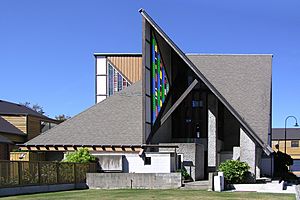
Before Europeans arrived, native Māori religion believed in many gods (polytheistic). A major part of it was tapu (sacred and/or forbidden). This was used to keep the status of chiefs and tohunga (priests) and also to help save resources. Some of the first European settlers in New Zealand were Christian missionaries, mostly from the Church of England, but also from Protestant groups and the Catholic Church. From the 1830s onwards, many Māori became Christian. Throughout the 1800s, several movements appeared that mixed traditional Māori beliefs with Christianity. These included Pai Marire, Ringatu, and later, Ratana. These churches usually centered around a prophet-leader. They still have many followers today. In 2013, 50,565 people were Ratana believers, and 16,419 were Ringatu. 1,689 people said they followed Māori religion. Many Māori who belong to mainstream churches, or have no particular religion, still believe in tapu, especially when it comes to the dead.
Pākehā have become less religious over the 1900s. In the 1920s, there was still some prejudice between different Christian groups, but this has since faded. The main churches generally work together now. Churches and religious groups have little political power when it comes to Pākehā. Most religious Pākehā are Christian, but a small number follow non-Christian religions, especially Buddhism. A larger number have a general belief in new age ideas, like the healing power of crystals.
In 2013, the number of people who said they were Christian (including Māori Christian) went down to 1,906,398. This was 48.9% of all people who stated their religion, down from 55.6% in 2006. The number of people following non-Christian religions has increased since 2006. As of 2013, there were 88,919 Hindus, 46,149 Muslims, and 19,191 Sikhs. The number of people who said they had no religion increased between 2006 and 2013. In 2013, more than 2 in 5 people (41.9%) reported having no religion. This means 1,635,345 New Zealanders identified with no religion in the 2013 census.
Travel
It is very common for New Zealanders to travel or live overseas for long periods, often on working holidays. These trips are usually called the 'OE' or 'overseas experience'. They are most commonly taken by people in their 20s. The three most popular places to go are Australia, Great Britain, and Europe. Recently, trips to Asian countries like South Korea and Japan to teach English have become more popular. The east coast of Australia and London both have large communities of New Zealanders living there.
The OE to Europe is usually paid for by the traveler themselves. It often happens a few years after university graduation, once the traveler has saved enough money for flights and living costs. The trip can last from a few months to many years. Many New Zealanders have British ancestors or dual citizenship, so they might not have the same restrictions on working in Britain.
Working holidays in Asia are more likely to happen soon after graduation. Many agencies specifically target graduates for these trips. Because Australia is close to New Zealand and has no restrictions on New Zealanders working there, the New Zealanders working in Australia are more diverse. This includes a higher number of Māori and working-class people.
Since the Trans-Tasman Travel Arrangement was signed in 1973, New Zealanders have been able to live and work in Australia with the same rights as Australian citizens. Until the 1970s, New Zealanders had similar rights in Britain. Changes to British immigration law at that time meant New Zealanders needed visas to work or live in Britain for long periods, unless they had recent British ancestry.
New Zealand has many agreements with other countries for working holidays. These allow people in their 20s to live and work overseas, usually for up to a year. Such agreements are in place with countries like Argentina, Canada, France, Germany, Japan, South Korea, the United Kingdom, and many others.
Food
Māori cuisine
Māori food was historically based on food from tropical Polynesia, but adapted for New Zealand's colder weather. Key ingredients included kūmara (sweet potato), fern root, taro, birds, and fish. Food was cooked in hāngi (earth ovens) or roasted. In geothermal areas, food was boiled or steamed using natural hot springs. Different ways of preserving birds and other foods were also used. Māori were one of the few peoples who did not have any kind of alcoholic beverage.
After British settlers arrived, Māori adopted many of their foods, especially pork and potatoes. Potatoes changed the Māori farming economy. Many traditional food sources became scarce as new animals introduced by settlers reduced bird populations. Forests were also cleared for farming and timber. Traditional seafoods like toheroa and whitebait were over-harvested. Today, Māori food is a mix of Māori tradition, old-fashioned English cooking, and modern dishes. In daily life, two foods of Māori origin are "the boil up" (boiled leftover meat and vegetables) and the hāngi, which is used for special occasions.
Pākehā cuisine
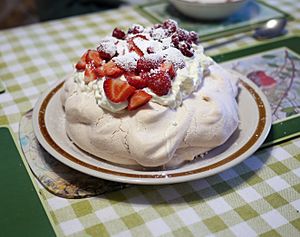
Most Pākehā are of British descent, so Pākehā food is very similar to British cuisine. In the 1800s, British settlers in New Zealand tried to make the foods from their homeland as much as possible. A big difference was that meat was much easier for everyone to get in New Zealand. A diet with a lot of meat is still part of Pākehā culture, though red meat eating has gone down in recent decades. Like the British, Pākehā have traditionally loved sweet foods. The best of traditional Pākehā cooking includes cakes, scones, muffins, and desserts.
In recent decades, Pākehā have discovered 'ethnic' food, and a 'foodie' culture has grown. Most Pākehā food is not very different from modern British food. However, New Zealand chefs like Peter Gordon played a big part in creating fusion cuisine, which mixes different food styles.
Other cuisines
New Zealanders now come from many different backgrounds. Most immigrants have tried to make their native foods or national dishes in New Zealand. Ethnic restaurants have become places for communities to meet. They also give other New Zealanders a chance to try different foods.
The growth of café culture has been a big part of New Zealand's development. Cafés and excellent espresso coffee making throughout most of New Zealand have created a unique part of the country's daily life.
Sports
The sports most New Zealanders play are rugby union, cricket, basketball, netball, association football (which is the most popular sport among children), rugby league, and hockey. Other popular sports include golf, tennis, cycling, and many water sports, especially sailing and rowing. New Zealand is known for its extreme sports, adventure tourism, and strong mountaineering tradition. A famous example is Sir Edmund Hillary, who was the first to climb Mount Everest.
The national rugby union team is called the All Blacks. They have the best winning record of any national team in the world. They were also the first winners of the Rugby World Cup in 1987. The style of naming national teams has been copied in several other sports. For example, the national basketball team is known as the Tall Blacks.
Horseracing was also a popular sport to watch and became part of the "rugby, racing, and beer" culture in the 1960s. Many New Zealanders either play or support their local rugby team, and the All Blacks are national heroes. Some people even say that rugby is like a national religion.
Images for kids
-
A beach barbecue – an established part of New Zealand culture
-
A modern wharenui (meeting house of a marae) exhibited at the Museum of New Zealand Te Papa Tongarewa
-
Knox Church, a Presbyterian church, in Dunedin. The city was founded by Scottish Presbyterian settlers.
See also
 In Spanish: Cultura de Nueva Zelanda para niños
In Spanish: Cultura de Nueva Zelanda para niños




